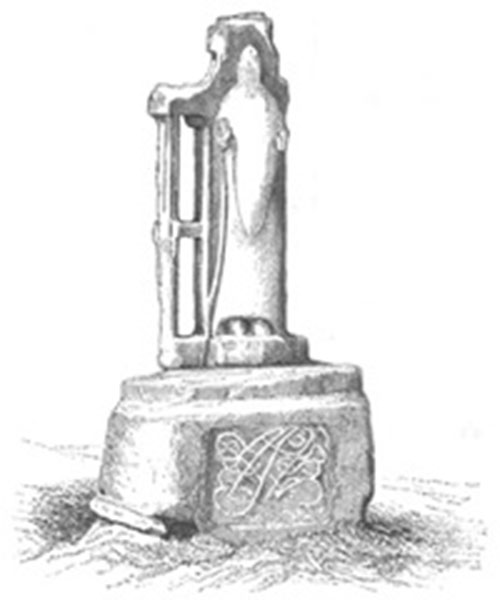Cross of Cashel - Irish Pictures (1888)
From Irish Pictures Drawn with Pen and Pencil (1888) by Richard Lovett
Chapter IV: From Dublin to Cork … continued
« Previous Page | Start of Chapter | Book Contents | Next Page »
In the cemetery adjoining the buildings there are no ancient crosses like those at Monasterboice; but near the entrance to the cathedral stands what is known as the 'Cross of Cashel.' This when complete must have been a very fine piece of work. It is now greatly dilapidated, but enough of its ornamentation can be made out to prove that it most probably dates from the twelfth century. The figure cut in the stone is supposed to be St. Patrick, and the Kings of Munster are said to have been crowned while standing on its pedestal.
As already noted, the cathedral dates from the latter half of the twelfth century, but most of the work now standing was built about the close of the fourteenth. It is 260 feet long and 170 feet wide at the transept, and a large part of the fine central tower is still standing. It may be easily ascended, and from the top one of the best views in the south of Ireland is to be obtained. It was intact and used for Divine worship until the time of Archbishop Price, 1744-1752, who, according to tradition, not being able to drive his carriage up to the church-door, obtained an Act of Parliament to remove the cathedral to the town, and unroofed the old building for the sake of its lead! All subsequent attempts to restore it failed, and it now remains a melancholy but a picturesque ruin.
The Rock of Cashel affords material for a whole volume of antiquarian disquisition. Few places better reward the time spent in acquiring a fair knowledge of the remains and their story; but, like Glendalough, the charm of the place does not depend wholly upon these. The lover of the beautiful can indulge his passion here, and find ample satisfaction. Standing on the ruined cathedral tower, or strolling along the edge of the rock which slopes abruptly away from the observer's feet, a magnificent expanse of country stretches out before him. His eye ranges over one of the most fertile tracts of Ireland, the Golden Vale of Tipperary. Away to the north is the beautiful river scene where stands Holy Cross Abbey, on the banks of the Suir; and further beyond, the town of Thurles, and the Devil's Bit Mountain, the spot whence the Prince of Darkness, according to popular tradition, snapped the Rock of Cashel in a fit of hunger and weariness, but soon dropped it in disgust. To the south are the rich lands of Tipperary, lying warm and luxuriant in the sunshine, having a superb background in the distant Galty Mountains; while in the western distance are the summits of the Slieve Phelim hills, beyond which is the busy town of Limerick. It is a scene upon which the delighted eye loves to linger, and which, when once enjoyed under favourable conditions, lives long in the memory. And if, under the influence of so much and such rich natural beauty, one tends to forget the past, and to rejoice only in the happy present, the past which is so powerfully represented on the Rock asserts itself even in the landscape, for as the eye returns from the peaks of the Galty Mountains, or from the rich colouring of the distant plain, it falls upon the ruined towers and arches of Hore Abbey, which rise in the immediate foreground, and carry the thoughts back once again to the men and the life of five centuries ago.
« Previous Page | Start of Chapter | Book Contents | Next Page »

